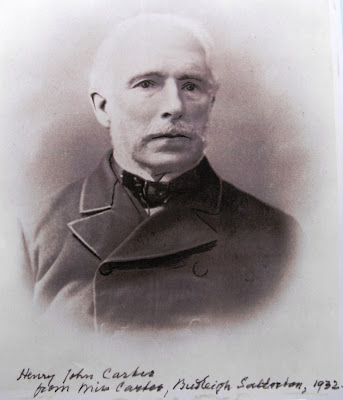Sea, Salt and Sponges
Fairlynch Museum’s 2013 exhibition has a maritime theme: the history of local fishing and salt-making, marine conservation, paintings by local artists inspired by the area’s beautiful coastal scenery… but especially the life of Henry Carter FRS (1813-95), born 200 years ago in Budleigh Salterton. The exhibition opens on Friday 29 March at 2.00 pm and runs until the end of September 2013. Admission is free.
Here are some facts about Henry Carter:
• The first to describe the microscopic aquatic creature Collodictyon triciliatum, declared by scientists recently to be one of the world's oldest living organisms and man's remotest relative…
Image credit: Robert Clinton Rhodes
• Admired for his “wonderful” description of the sex-life of algae by Charles Darwin
• “No obscure scientist could hope for a more
constant friend or more courteous correspondent than H.J. Carter Esq, of Devonshire , England

• Was the first to describe microscopic creepy-crawly amoeboid organisms such as Acanthocystis turfacea, Euglypha compressa, Pontigulasia compressa and Difflugia urceolata that he found in drains and bog-water in the Budleigh area during the 1860s
Pictured above: Euglypha compressa Carter 1864
Image credit: Chris Carter and www.ptyxis.com
• Was the first to publish an Anglo-Mahrah vocabulary based on his experience with the Mahrah tribe of Southern Arabia
• Quoted in Jabez Hogg's best-selling book The
Microscope (1854) as one of Victorian Britain's top microscopists along with
Fellows of the Royal Society such as William Carpenter, Charles Darwin, Philip
Gosse and Thomas Huxley
• Shared the honour of having a fungus — Chionyphe Carteri — named after him along
with the illustrator of the medical text-book Gray's Anatomy
• Awarded the Royal Society's Royal Medal
in 1872
• Has a fossil from the Burgess shale in British Columbia

• Has at least 27 different species of sponge named after him
Above: Oscarella lobularis: one of the sponges found by Henry Carter at Budleigh Salterton
Image credit: Parent Gery
• Involved with the 1870s excavation of the
prehistoric Labyrinthodont remains discovered in the Triassic sandstone strata
between Budleigh Salterton and Sidmouth
• Has the Arabian Frankincense tree named
after him
• Condemned the Indian caste system in 1843
for its inhumanity

• Reorganised the
Above: Xestospongia testudinaria, known as the barrel sponge: one of the sponges described by Henry Carter
Image credit: Jan Messersmith
• Reorganised Liverpool Museum
• “This able and indefatigable naturalist... a
wonderfully careful and accurate observer” — Arthur Dendy (1865-1925),
Australian zoologist
• Was the first Westerner to describe the
ancient Arabian city of Al Baleed

• The first naturalist to describe the development of Euplectella aspergillum, also known as the Venus flower basket sponge — pictured above — chosen as one of Sir David Attenborough's Top Ten prized animals on Earth in November 2012
Image credit: NOAA/Monterey Bay Aquarium Research Institute
• Noted for his research while in India

• Has a species of gecko named after him
Above: Pristurus carteri, also known as Carter's Rock Gecko
Image credit: Todd Pierson
• Described as the writer who best deserved
the respect and gratitude of Indian geologists
• Was one of the first of the Anglo-Indian
ex-army officers to settle in Budleigh Salterton, people who were characterised
— in the words of the East
Devon novelist R.F. Delderfield — by their “hard, blue eyes,
fierce moustaches, and mahogany faces”
• Has been recently evoked in a book co-authored by Ishrat Syed and Kalpana Swaminathan, writing under the name of Kalpish Ratna. Published in 2012, Once Upon A Hill is a protest against the madness and greed which has alienated humanity from the natural world. It pays tribute to Carter's geological adventures in
• “Few if any of his contemporaries could match his genius” — Rob van Soest, former head curator of the Invertebrate section at the Zoological Museum of Amsterdam and Editor-in- Chief of the World Porifera Database
• Is the only native-born East
Devon scientist and Fellow of the Royal Society to end his days in
his homeland

Above: The freshwater sponge Spongilla lacustris, described by Henry Carter
Image credit: Kirt L. Onthank
• In a letter of 30 May 1872 written from Budleigh Salterton described how he was devoting his leisure to "scientific studies" in order to follow the precept of "making fellow-creatures better and happy"
• Has been honoured with a blue plaque on the wall of Umbrella Cottage, his Budleigh Salterton home








Comments
Post a Comment